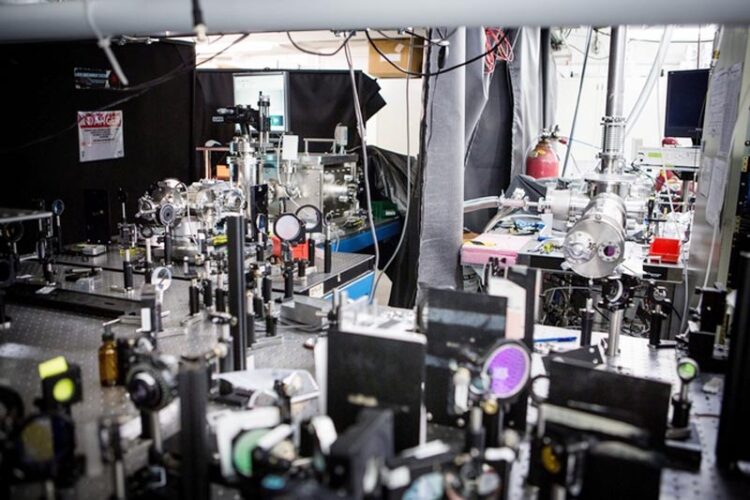Exploiting dark autoionizing states

An international research team led by Professors Tsuneyuki Ozaki and François Légaré at the Institut national de la recherche scientifique (INRS) in Canada, has developed a unique method to enhance the power of a laser source emitting extreme ultraviolet light pulses.
Credit: INRS
… for enhancing the extreme ultraviolet laser power.
A research team unravels a new optical phenomenon involving dark autoionizing states, enhancing the power of an extreme-ultraviolet laser.
An international research team led by Professors Tsuneyuki Ozaki and François Légaré at the Institut national de la recherche scientifique (INRS), has developed a unique method to enhance the power of a laser source emitting extreme ultraviolet light pulses. The underlying mechanism of the newly observed phenomenon involves the unique role of dark-autoionizing states through coupling with other pertinent electronic states. Thanks to this work, the team will be able to study the ultrafast dynamics of a single dark autoionizing state at the femtosecond timescale, which was previously impossible due to its inability to undergo single-photon emission or absorption, combined with the ultrashort lifetime of these states.
Recently published in the journal Physical Review Letters, their results allow the generation of ultrafast extreme ultraviolet light relevant for advanced ultrafast science applications such as angle-resolved photoemission spectroscopy and photoemission electron microscopy.
This work was done in collaboration with Professor Vasily Strelkov at the Prokhorov General Physics Institute of the Russian Academy of Sciences, Russia, and Research Assistant Professor Muhammad Ashiq Fareed at the University of Nebraska-Lincoln, USA.
Unravelling the mysteries of the dark-autoionizing states
In their laboratories at the Énergie Matériaux Télécommunications Research Centre, Professors Tsuneyuki Ozaki and François Légaré, along with PhD student Mangaljit Singh, have been exploiting special types of electronic states, known as dark-autoionizing states. Their work was accomplished using high-order harmonic generation, an optical phenomenon unconventional to laser physics.
“The newly published results are a step forward not only in understanding the behaviour of dark autoionizing states under intense ultrafast laser-matter interactions, but also in bringing intense extreme-ultraviolet laser sources from large-scale synchrotron and free-electron laser facilities to the moderate-sized laser laboratories,” says PhD student Mangaljit Singh, first author of the study.
Many limitations imposed by the fundamentals of laser physics restrict most lasers used in medicine, communications, or industry. Likewise, they tend to operate only in the ultraviolet, visible (from violet to red), or the invisible near and mid-infrared wavelength range. However, many advanced scientific applications require lasers to operate at shorter wavelengths in the extreme ultraviolet range. The state-of-the-art systems employ commercially available primary laser sources for high-order harmonic generation from noble gases to develop secondary sources of coherent extreme ultraviolet light.
In this study, instead of noble gases, Singh and colleagues used a laser-ablated plume (obtained from the laser ablation of a solid material) for the high-order harmonic generation in sync with the unique response of dark-autoionizing states.
They found that under certain resonance conditions governed by the primary laser parameters and the electronic structure of the atomic and ionic species in the laser-ablated plume, the conversion efficiency, and hence the power of the extreme ultraviolet laser source is enhanced by more than ten times. This implies that the same extreme ultraviolet power can be obtained using a primary laser with power that is one-tenth of the power required for a typical noble gas.
In addition to providing an intense extreme ultraviolet light source, this study also shows for the first time the prospect of studying the dynamics of dark autoionizing states at the femtosecond timescale using the technique of high harmonic spectroscopy. Such dark states could be the basis of several quantum technologies, especially in improving the performance of quantum computation.
The experiments were performed at the Advanced Laser Light Source (ALLS) laboratory at the INRS, a unique laser-based infrastructure providing a coherent rainbow of light and cutting-edge end-stations to its users. ALLS is part of LaserNetUS, a consortium of high-power laser facilities around North America that is advancing the frontiers of laser-science research.
About the study
The article “Ultrafast resonant state formation by the coupling of Rydberg and dark autoionizing states”, by Mangaljit Singh, Muhammad Ashiq Fareed, Valeryia Birulia, Alexander Magunov, Alexei N. Grum-Grzhimailo, Philippe Lassonde, Antoine Laramée, Romain Marcelino, Ramin Ghahri Shirinabadi, François Légaré, Tsuneyuki Ozaki and Vasily Strelkov, was published in the journal Physical Review Letters. The study received financial support from the Natural Sciences and Engineering Research Council of Canada.
Journal: Physical Review Letters
DOI: 10.1103/PhysRevLett.130.073201
Subject of Research: Not applicable
Article Title: Ultrafast resonant state formation by the coupling of Rydberg and dark autoionizing states
Article Publication Date: 17-Feb-2023
Media Contact
Julie Robert
Institut national de la recherche scientifique – INRS
julie.robert@inrs.ca
Office: 514 971 4747
Original Source
All latest news from the category: Physics and Astronomy
This area deals with the fundamental laws and building blocks of nature and how they interact, the properties and the behavior of matter, and research into space and time and their structures.
innovations-report provides in-depth reports and articles on subjects such as astrophysics, laser technologies, nuclear, quantum, particle and solid-state physics, nanotechnologies, planetary research and findings (Mars, Venus) and developments related to the Hubble Telescope.
Newest articles

First-of-its-kind study uses remote sensing to monitor plastic debris in rivers and lakes
Remote sensing creates a cost-effective solution to monitoring plastic pollution. A first-of-its-kind study from researchers at the University of Minnesota Twin Cities shows how remote sensing can help monitor and…

Laser-based artificial neuron mimics nerve cell functions at lightning speed
With a processing speed a billion times faster than nature, chip-based laser neuron could help advance AI tasks such as pattern recognition and sequence prediction. Researchers have developed a laser-based…

Optimising the processing of plastic waste
Just one look in the yellow bin reveals a colourful jumble of different types of plastic. However, the purer and more uniform plastic waste is, the easier it is to…


